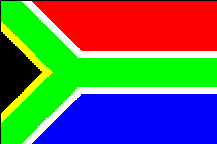


Names:
conventional long form: Republic of South Africa
conventional short form: South Africa
Abbreviation: RSA
Digraph: SF
Type: republic
Capital: Pretoria (administrative); Cape Town (legislative); Bloemfontein (judicial)
Administrative divisions: 9 provinces; Eastern Cape, Eastern Transvaal, KwaZulu/Natal, Northern Cape, Northern Transvaal, Northwest, Orange Free State, Gauteng, Western Cape
Independence: 31 May 1910 (from UK)
National holiday: Freedom Day, 27 April (1994)
Constitution: 27 April 1994 (interim constitution, replacing the constitution of 3 September 1984)
Legal system: based on Roman-Dutch law and English common law; accepts compulsory ICJ jurisdiction, with reservations
Suffrage: 18 years of age; universal
Executive branch:
chief of state and head of government: Executive President Nelson MANDELA (since 10 May 1994); Deputy Executive
President Thabo MBEKI (since 10 May 1994); Deputy Executive President Frederik
W. DE KLERK (since 10 May 1994)
note: any political party that wins 20% or more of the National Assembly
votes in a general election is entitled to name a Deputy Executive President
cabinet: Cabinet appointed by the Executive President
Legislative branch: bicameral
National Assembly: elections last held 26-29 April 1994 (next to be held NA); results
- ANC 62.6%, NP 20.4%, IFP 10.5%, FF 2.2%, DP 1.7%, PAC 1.2%, ACDP 0.5%,
other 0.9%; seats - (400 total) ANC 252, NP 82, IFP 43, FF 9, DP 7, PAC 5,
ACDP 2
Senate: the Senate is composed of members who are nominated by the nine provincial
parliaments (which are elected in parallel with the National Assembly) and
has special powers to protect regional interests, including the right to
limited self-determination for ethnic minorities; seats - (90 total) ANC
61, NP 17, FF 4, IFP 5, DP 3
note: when the National Assembly meets in joint session with the Senate to
consider the provisions of the constitution, the combined group is referred
to as the Constitutional Assembly
Judicial branch: Supreme Court
Political parties and leaders: African National Congress (ANC), Nelson MANDELA, president; National
Party (NP), Frederik W. DE KLERK, president; Inkatha Freedom Party (IFP),
Mangosuthu BUTHELEZI, president; Freedom Front (FF), Constand VILJOEN, president;
Democratic Party (DP); Pan Africanist Congress (PAC), Clarence MAKWETU, president;
African Christian Democratic Party (ACDP), leader NA
note: in addition to these seven parties which received seats in the National
Assembly, twelve other parties won votes in the national elections in April
1994
Other political or pressure groups: NA;;
Member of: BIS, C, CCC, ECA, FAO, GATT, IAEA, IBRD, ICAO, ICC, ICRM, IDA, IFC,
IFRCS, ILO, IMF, INMARSAT, INTELSAT, INTERPOL, IOC, ISO, ITU, NAM, OAU, SACU,
SADC, UN, UNCTAD, UPU, WFTU, WHO, WIPO, WMO, ZC
Flag: two equal width horizontal bands of red (top) and blue separated by
a central green band which splits into a horozontal Y, the arms of which
end at the corners of the hoist side, embracing a black isoceles triangle
from which the arms are separated by narrow yellow bands; the red and blue
bands are separated from the green band and its arms by narrow white stripes
note: prior to 26 April 1994, the flag was actually four flags in one - three
miniature flags reproduced in the center of the white band of the former
flag of the Netherlands, which has three equal horizontal bands of orange
(top), white, and blue; the miniature flags are a vertically hanging flag
of the old Orange Free State with a horizontal flag of the UK adjoining on
the hoist side and a horizontal flag of the old Transvaal Republic adjoining
on the other side